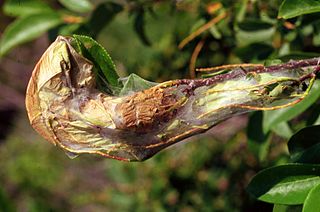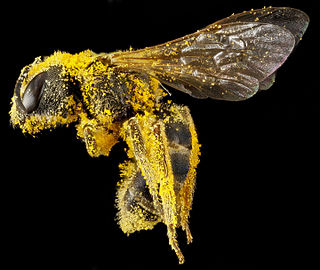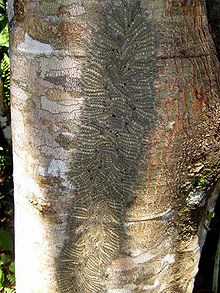
An ectotherm, more commonly referred to as a "cold-bloodedanimal", is an animal in which internal physiological sources of heat are of relatively small or of quite negligible importance in controlling body temperature. Such organisms rely on environmental heat sources, which permit them to operate at very economical metabolic rates.

The eastern tent caterpillar is a species of moth in the family Lasiocampidae, the tent caterpillars or lappet moths. It is univoltine, producing one generation per year. It is a tent caterpillar, a social species that forms communal nests in the branches of trees. It is sometimes confused with the spongy moth and the fall webworm, and may be erroneously referred to as a bagworm, which is the common name applied to unrelated caterpillars in the family Psychidae. The moths oviposit almost exclusively on trees in the plant family Rosaceae, particularly cherry (Prunus) and apple (Malus). The caterpillars are hairy with areas of blue, white, black and orange. The blue and white colors are structural colors created by the selective filtering of light by microtubules that arise on the cuticle.

The forest tent caterpillar moth is a moth found throughout North America, especially in the eastern regions. Unlike related tent caterpillar species, the larvae of forest tent caterpillars do not make tents, but rather, weave a silky sheet where they lie together during molting. They also lay down strands of silk as they move over branches and travel as groups along these pheromone-containing silk trails. The caterpillars are social, traveling together to feed and massing as a group at rest. Group behavior diminishes as the caterpillars increase in size, so that by the fifth instar (molt) the caterpillars are feeding and resting independently.

Tent caterpillars are moderately sized caterpillars, or moth larvae, belonging to the genus Malacosoma in the family Lasiocampidae. Twenty-six species have been described, six of which occur in North America and the rest in Eurasia. Some species are considered to have subspecies as well. They are often considered pests for their habit of defoliating trees. They are among the most social of all caterpillars and exhibit many noteworthy behaviors.

Eciton burchellii is a species of New World army ant in the genus Eciton. This species performs expansive, organized swarm raids that give it the informal name, Eciton army ant. This species displays a high degree of worker polymorphism. Sterile workers are of four discrete size-castes: minors, medias, porters (sub-majors), and soldiers (majors). Soldiers have much larger heads and specialized mandibles for defense. In lieu of underground excavated nests, colonies of E. burchellii form temporary living nests known as bivouacs, which are composed of hanging live worker bodies and which can be disassembled and relocated during colony emigrations. Eciton burchellii colonies cycle between stationary phases and nomadic phases when the colony emigrates nightly. These alternating phases of emigration frequency are governed by coinciding brood developmental stages. Group foraging efforts known as "raids" are maintained by the use of pheromones, can be 200 metres (660 ft) long, and employ up to 200,000 ants. Workers are also adept at making living structures out of their own bodies to improve efficiency of moving as a group across the forest floor while foraging or emigrating. Workers can fill "potholes" in the foraging trail with their own bodies, and can also form living bridges. Numerous antbirds prey on the Eciton burchellii by using their raids as a source of food. In terms of geographical distribution, this species is found in the Amazon jungle and Central America.

Formica polyctena is a species of European red wood ant in the genus Formica and large family Formicidae. The species was first described by Arnold Förster in 1850. The latin species name polyctena is from Greek and literally means 'many cattle', referring to the species' habit of farming aphids for honeydew food. It is found in many European countries. It is a eusocial species, that has a distinct caste system of sterile workers and a very small reproductive caste. The ants have a genetic based cue that allow them to identify which other ants are members of their nest and which are foreign individuals. When facing these types of foreign invaders the F. polyctena has a system to activate an alarm. It can release pheromones which can trigger an alarm response in other nearby ants.

Epargyreus clarus, the silver-spotted skipper, is a butterfly of the family Hesperiidae. It is claimed to be the most recognized skipper in North America. E. clarus occurs in fields, gardens, and at forest edges and ranges from southern Canada throughout most of the United States to northern Mexico, but is absent in the Great Basin and western Texas.

Malacosoma californicum, the western tent caterpillar, is a moth of the family Lasiocampidae. It is a tent caterpillar. The Western Tent Caterpillar is found in southern Canada, the western United States, and parts of northern Mexico. There are currently six recognized subspecies of M. californicum. Western tent caterpillars are gregarious and will spend a large portion of their time with other caterpillars in silken tents constructed during their larval stage.

Eriogaster lanestris, commonly known as the small eggar, is a moth of the family Lasiocampidae that is found across the Palearctic. Unlike many other members of the Lasiocampidae, the small eggar is a social insect. Historically, only eusocial insects like ants, bees, and termites were thought to exhibit complex social organization and communication systems. However, research since the late 20th century has found that E. lanestris, among a number of other phylogenetically related moth and butterfly species, demonstrates social behaviors as well. Larvae spend nearly their entire development in colonies of about 200 individuals, and this grouped social structure offers a number of benefits, from thermoregulation to increased foraging success.

Eusociality, the highest level of organization of sociality, is defined by the following characteristics: cooperative brood care, overlapping generations within a colony of adults, and a division of labor into reproductive and non-reproductive groups. The division of labor creates specialized behavioral groups within an animal society which are sometimes referred to as 'castes'. Eusociality is distinguished from all other social systems because individuals of at least one caste usually lose the ability to perform at least one behavior characteristic of individuals in another caste. Eusocial colonies can be viewed as superorganisms.

Ropalidia marginata is an Old World species of paper wasp. It is primitively eusocial, not showing the same bias in brood care seen in other social insects with greater asymmetry in relatedness. The species employs a variety of colony founding strategies, sometimes with single founders and sometimes in groups of variable number. The queen does not use physical dominance to control workers; there is evidence of pheromones being used to suppress other female workers from overtaking queenship.
Eutachyptera is a monotypic moth genus in the family Lasiocampidae. The genus was erected by William Barnes and James Halliday McDunnough in 1912. Its single species, Eutachyptera psidii, was first described by Sallé in 1857. It is found in Mexico.

Within the insect order Hymenoptera, the Halictinae are the largest, most diverse, and most recently diverged of the four halictid subfamilies. They comprise over 2400 bee species belonging to the five taxonomic tribes Augochlorini, Thrinchostomini, Caenohalictini, Sphecodini, and Halictini, which some entomologists alternatively organize into the two tribes Augochlorini and Halictini.
The thin-waisted social wasps, which typically reside in Neotropical regions from Central to South America, are a small genus of wasps that build nests and live in colonies ranging in size from 1 to 18 members. Microstigmus is widely considered to be the only true eusocial species within the family Crabronidae. Like all Hymenoptera, Microstigmus has an interesting sex determination pattern. Females are 2n (diploid), spawning from eggs that have been fertilized, while males are 1n (haploid) and spawn from unfertilized eggs. Female wasps contain the eggs within their egg sac and have the option of fertilizing them or not, thus having complete control of the gender of their offspring. This wasp genus, part of the suborder Apocrita, is distinguished physically by the narrow waist (petiole) between the end segment of the thorax (mesosoma) and the beginning of the abdomen (metasoma). Specifically, it is in the subgroup of "apoid wasps", those that exhibit social behavior in nesting and foraging. Evidence does exist that in some species social altruism is visible; however, studies on these topics have been limited. The small size and enclosed nest structure makes it difficult to obtain significant data. Although it was originally classified under the Sphecidae family due to its elongated petiole, Microstigmus has been reclassified into the new Crabronidae family.

Structures built by non-human animals, often called animal architecture, are common in many species. Examples of animal structures include termite mounds, ant hills, wasp and beehives, burrow complexes, beaver dams, elaborate nests of birds, and webs of spiders.

Archips cerasivorana, the ugly-nest caterpillar moth, is a species of moth of the family Tortricidae. The caterpillars of this species are known to create nests by tying the leaves of their host plant together. Within the nests, they live and feed off the leaves that have been tied together. The larvae are brownish or greenish yellow with a shiny dark brown head. Larvae can be found from May to July. The species overwinters as an egg, and pupation takes place within the nest. Caterpillars are seen to follow one another in trails, a behavior prompted by the release of signaling pheromones from their spinnerets.

Eucheira socialis, commonly known as the Madrone butterfly is a lepidopteran that belongs to the family Pieridae. It was first described by Westwood in 1834. Locally known as Mariposa del madroño or tzauhquiocuilin, it is endemic to the highlands of Mexico, and exclusively relies on the Madrone as a host-plant. The species is of considerable interest to lepidopterists due to gregarious nest-building in the larval stages, and heavily male biased sex ratio. It takes an entire year for this adult butterfly to develop from an egg. The eggs are laid in the month of June and the adults emerge the following May–June. The adults have a black and white pattern on their wings, and the males are generally much smaller and paler than the females. The larvae do not undergo diapause and continue to feed and grow communally in the coldest months of the year. There are two subspecies of E. socialis, named E. socialis socialis and E. socialis westwoodi.

Halictus ligatus is a species of sweat bee from the family Halictidae, among the species that mine or burrow into the ground to create their nests. H. ligatus, like Lasioglossum zephyrus, is a primitively eusocial bee species, in which aggression is one of the most influential behaviors for establishing hierarchy within the colony, and H. ligatus exhibits both reproductive division of labor and overlapping generations.

The Central American paper wasp is a nocturnal eusocial wasp. It is famous for its swarm based emigration behavior, and is native to the lowlands of Central and northern South America. This species has developed special night vision adaptations to facilitate their night-time swarming and foraging behavior and has important medicinal properties for the Pankararú people of Brazil.

Polybia sericea is a social, tropical wasp of the family Vespidae that can be found in South America. It founds its colonies by swarming migrations, and feeds on nectar and arthropods.


















